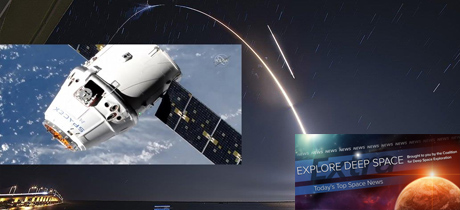In Today’s Deep Space Extra… Vice President Mike Pence reasserts the administration’s commitment to space in a speech at the 2019 Satellite Conference. NASA’s latest cargo mission to the six person International Space Station (ISS) reached its destination early Monday as the ISS hits its stride in science. NASA’s plans for a human landing in 2024 begin to take shape.
Human Space Exploration
Pence reaffirms administration’s support for space
SpaceNews.com (5/6): In a Monday speech before the Satellite 2019 Conference in Washington, U.S. Vice President Mike Pence endorsed a White House commitment to moving ahead in space without making specific new announcements. “Since day one of our administration, we’ve worked to restore America’s proud leadership in space,” said the vice president. “Leadership is essential to our nation’s security, our prosperity and our very way of life.”
SpaceX cargo ship reaches Space Station
Spaceflightnow.com/CBS News (5/6): Early Monday, NASA’s 17th NASA SpaceX contracted resupply mission to the International Space Station (ISS) carried out a successful rendezvous to deliver more than 5,500 pounds of crew supplies, scientific equipment and technology equipment.
NASA’s plan for a human lunar landing in 2024 takes shape
Coalition Member in the News – Lockheed Martin
The Space Review (5/6): A summary look at how NASA’s goal of returning to the surface of the Moon with human explorers in 2024 is currently envisioned. The second launch of NASA’s Space Launch System (SLS) with an Orion capsule and astronauts aboard will depart NASA’s Kennedy Space Center (KSC) for a lunar orbiting, human tended Gateway. There they will move to a lander and descend to the Moon’s south pole, a destination not previously visited.
Space Science
This awesome spiral galaxy view from Hubble may help demystify black holes
Space.com (5/7): A recent image of the spiral galaxy NGC 2903, just 30 million light years from Earth, is providing astronomers with an improved understanding of the super massive black holes that reside in the midst of star systems like the Milky Way.
The International Space Station (ISS) has found its scientific calling
Sciencemag.org (5/2): The ISS has never been known as a hotbed of science, even though the U.S. and partner nations spent more than $100 billion to build it. Inside its cramped bays, astronauts study the biological effects of microgravity, and a few astrophysical experiments are mounted to its exterior. But 2 decades after it started to take shape, the ISS has finally found a scientific calling: looking down at its home planet.
Other News
Meet the photographer behind NASA’s stunning images
NBC News (5/6): Bill Ingalls has photographed NASA’s triumphs and tragedies, chronicling the nation’s space program for more than 3 decades, expertly capturing the space agency’s rocket launches and critical moments — even shooting a vehicle test inside an active volcano.
Former U.S. officials sign open letter in support of DoD’s Space Force proposal
SpaceNews.com (5/5): Establish a U.S. space force, say more than 40 former Department of Defense (DoD), U.S. Air Force and intelligence agency officials in a letter distributed to news agencies on Sunday.
How China is redrawing the map of world science
Nature.com (5/1): The Belt and Road Initiative, China’s mega-plan for global infrastructure, will transform the lives and work of tens of thousands of researchers.

